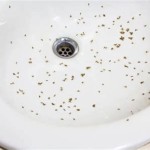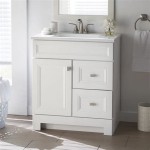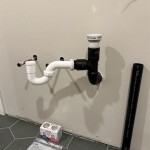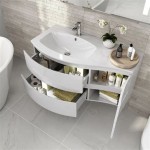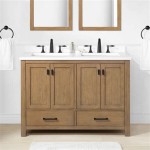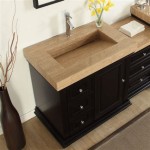Can I Paint My Bathroom Vanity Top? A Comprehensive Guide
The bathroom vanity is a focal point in many bathrooms, and its condition can significantly impact the overall aesthetic of the space. Over time, vanity tops can become worn, outdated, or simply no longer appealing to the homeowner. Replacing the entire vanity can be a costly and disruptive process. Painting, therefore, becomes an attractive alternative to refresh the vanity’s appearance. However, the question remains: can a bathroom vanity top be painted effectively and durably?
The answer is yes, but with caveats. The success of painting a bathroom vanity top hinges on several key factors, including the material of the existing top, the type of paint used, and the preparation involved. A poorly executed paint job can result in a finish that is easily chipped, scratched, or damaged by water and cleaning products. Consequently, a thorough understanding of the process, combined with meticulous execution, is crucial for achieving a long-lasting and aesthetically pleasing result.
Identifying the Vanity Top Material
The material of the vanity top is the most critical factor influencing the preparation and painting process. Common materials for bathroom vanity tops include laminate, solid surface (such as Corian), tile, wood (often sealed with polyurethane), and even natural stone (like granite or marble). Each material has unique properties and requires specific preparations to ensure proper paint adhesion and durability.
Laminate: Laminate vanity tops are generally constructed from a plastic laminate bonded to a particleboard or MDF core. Laminate surfaces are smooth and non-porous, making paint adhesion challenging. Special primers designed for slick surfaces are essential for priming laminate effectively. Without adequate priming, the paint is likely to peel or chip.
Solid Surface: Solid surface materials, such as Corian, are non-porous and more amenable to painting than laminate. However, proper sanding to create a slightly textured surface is still necessary to enhance paint adhesion. Adhesion promoters or specialized primers are beneficial, but the inherent properties of solid surface materials often lead to better results than painting over laminate.
Tile: Painting a tile vanity top presents a unique challenge due to grout lines. While paint can adhere to glazed tile with proper preparation, the grout lines will remain visible and can detract from the overall aesthetic if not addressed. Epoxy paints designed for tile surfaces are often recommended, along with careful cleaning and etching of the tile to improve adhesion. Consider the long-term maintenance involved, as grout lines can be difficult to keep clean after being painted.
Wood: Wood vanity tops, particularly those sealed with polyurethane, can be painted successfully. The existing finish must be sanded down to create a sound surface for the primer and paint to adhere to. The type of wood and the existing sealant will influence the coarseness of the sandpaper required. Proper sanding is critical to remove the sheen and create a ‘tooth’ for the paint to grip.
Natural Stone (Granite, Marble): Painting natural stone vanity tops is generally not recommended. Natural stone is porous and can absorb paint unevenly, leading to a blotchy and unattractive finish. Furthermore, paint can permanently stain the stone, making it difficult to restore to its original condition. While specialized epoxy coatings exist for stone, the results are often unpredictable, and the risk of damage outweighs the potential benefits. Consider alternative options like refinishing or replacing the vanity top if you are unhappy with the appearance of natural stone.
Preparing the Vanity Top for Painting
Proper preparation is the cornerstone of a successful vanity top painting project. No matter the material, a thorough cleaning and surface preparation are essential before applying any primer or paint. Neglecting this stage can result in a finish that is prone to peeling, chipping, or other forms of damage.
Cleaning: The first step is a thorough cleaning to remove any dirt, grease, soap scum, or other contaminants. Use a degreasing cleaner and scrub the surface vigorously. Rinse thoroughly with clean water and allow the vanity top to dry completely. For stubborn stains, a mild abrasive cleaner can be used cautiously, making sure not to damage the underlying material.
Sanding: Sanding is crucial for creating a textured surface that allows the primer and paint to adhere properly. The grit of sandpaper required will depend on the material. For laminate, start with a medium-grit sandpaper (around 120-150 grit) and lightly scuff the surface. For wood, use a coarser grit (around 80-100 grit) to remove the existing finish, followed by a finer grit (around 180-220 grit) to smooth the surface. For solid surface materials, a medium-grit sandpaper is generally sufficient. Clean all sanding dust with a tack cloth or a damp cloth.
Priming: Primer is essential for creating a strong bond between the existing surface and the paint. Choose a primer specifically designed for the material you are painting. For laminate, use an adhesion-promoting primer. For wood, use a stain-blocking primer to prevent tannins from bleeding through the paint. Apply the primer in thin, even coats, following the manufacturer's instructions. Allow the primer to dry completely before proceeding to the next step. Multiple coats of primer may be necessary for optimal adhesion, especially on slick surfaces like laminate.
Repairing Imperfections: Before painting, address any imperfections in the vanity top, such as chips, cracks, or dents. Use a wood filler or epoxy filler to fill in these imperfections. Allow the filler to dry completely, then sand it smooth to blend with the surrounding surface. Prime the repaired areas before painting.
Taping: Use painter's tape to protect any areas that you do not want to paint, such as the sink, faucet, or surrounding walls. Ensure that the tape is applied firmly and create clean lines. High-quality painter’s tape will prevent paint bleed and ensure a professional-looking finish.
Selecting the Right Paint and Application Techniques
Choosing the correct paint and applying it properly is crucial for achieving a durable and aesthetically pleasing finish on the bathroom vanity top. The bathroom environment is particularly demanding, with high humidity, potential water exposure, and frequent cleaning. Therefore, the paint must be able to withstand these conditions without peeling, chipping, or fading.
Paint Type: For bathroom vanity tops, epoxy-based paint or a high-quality acrylic latex paint specifically designed for cabinets and furniture is generally recommended. Epoxy paint offers excellent durability and water resistance, making it ideal for surfaces that are frequently exposed to moisture. Acrylic latex paints are easier to work with and clean up, but may not be as durable as epoxy paints. Consider selecting a paint with a satin or semi-gloss finish, as these finishes are more resistant to moisture and easier to clean than matte finishes.
Application Techniques: Apply the paint in thin, even coats, using a high-quality brush, roller, or paint sprayer. Avoid applying too much paint in one coat, as this can lead to drips and runs. Multiple thin coats are preferable to one thick coat. Allow each coat of paint to dry completely before applying the next coat. Lightly sand between coats with fine-grit sandpaper (around 220-320 grit) to smooth the surface and improve adhesion. Clean the sanding dust thoroughly before applying the next coat of paint.
Sealing: After the final coat of paint has dried completely, consider applying a clear sealant to further protect the surface from moisture and wear. Polyurethane or epoxy sealants are good choices for bathroom vanity tops. Apply the sealant in thin, even coats, following the manufacturer's instructions. Allow the sealant to dry completely before using the vanity top. Multiple coats of sealant may be necessary for optimal protection.
Curing Time: Allow the paint and sealant to cure completely before using the vanity top. Curing time can vary depending on the product and environmental conditions, typically ranging from several days to a couple of weeks. Avoid placing heavy objects on the vanity top during the curing period. Protect the surface from water and spills to ensure that the paint and sealant properly harden and cure.
In summary, painting a bathroom vanity top is a viable option for refreshing its appearance and extending its lifespan, but careful preparation, the selection of appropriate materials, and meticulous application are key to achieving a durable and aesthetically pleasing result. Factors such as the vanity top material, cleaning and sanding techniques, primer selection, paint type, application methods, and sealing are all critical considerations that must be addressed for a successful outcome.

Paint Bathroom Vanity Countertop Sink So Easy A Piece Of Rainbow

Paint Bathroom Vanity Countertop Sink So Easy A Piece Of Rainbow

Paint Bathroom Vanity Countertop Sink So Easy A Piece Of Rainbow
:strip_icc()/101922779-2cbc45e123c34827afb4f601723b03ca.jpg?strip=all)
How To Paint Bathroom Countertops

How To Paint A Bathroom Countertop Ace Hardware

Should You Be Painting Your Bathroom Countertops Caesarstone

I Chalk Painted My Countertops Lolly Jane

How To Paint Tile Countertops And Our Modern Bathroom Reveal Bright Green Door

I Have Always Wanted To Paint My Bathroom Countertop Hometalk

Paint Bathroom Vanity Countertop Sink So Easy A Piece Of Rainbow
Related Posts

